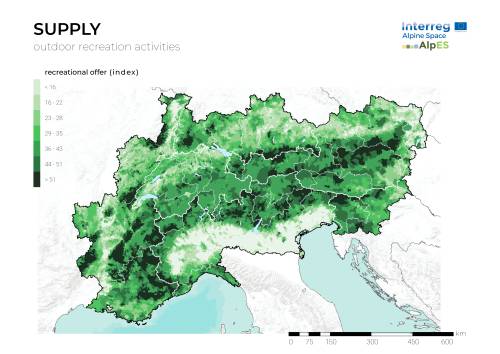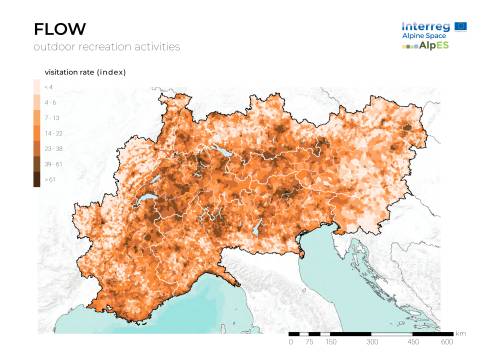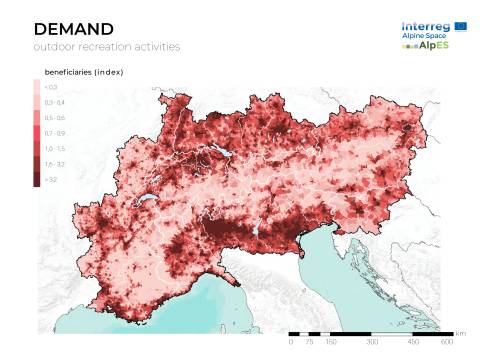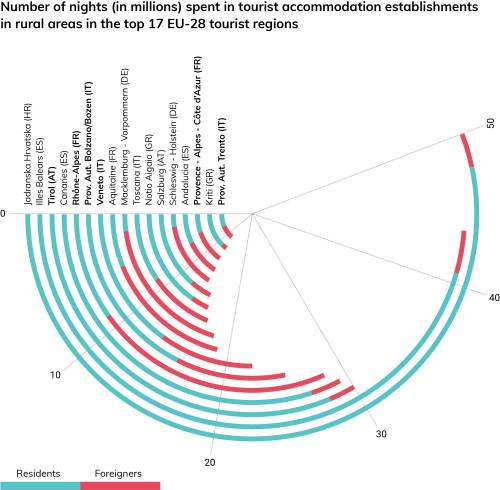Outdoor recreation activities
When discussing ecosystem services, most people imagine the material benefits humans receive from nature, such as clean drinking water, wood, and pollination of crops.
However, there exists a whole category of ecosystem services concerned with non-material benefits, entitled cultural ecosystem services. This category includes aesthetic
appreciation and inspiration, cultural identity, sense of home, and spiritual experience related to the natural environment. Typically, opportunities for recreation are considered within this category. Nature-based opportunities for recreation (e.g. walking and playing sports in parks and urban green spaces or hiking in the mountains) play an important role in maintaining mental and physical health, as many studies have demonstrated (Stigsdotter et al., 2010; Barton & Pretty, 2010). Measuring the potential benefit of outdoor recreation is an important piece in the Alpine Space puzzle. The three indicators for outdoor recreation activities assess the supply, flow, and demand of this service. In other words, they demonstrate how much open, natural, and accessible space exists for recreation, how many people are actually using these spaces, and the potential beneficiaries of outdoor recreation opportunities. In a landscape as beautiful as the Alps, the opportunities for outdoor recreation for both local and visiting populations comprise an enormous benefit.
Supply

View this map in the AlpES webGIS
Many factors contribute to the nature-related recreation potential of a place; the naturalness of the environment, its ruggedness and a diverse composition of the landscape are all characteristics that increase this potential. Moreover, national parks and nature reserves often attract visitors and can provide many outdoor opportunities and sometimes even wildlife-watching experiences. This indicator is a measure of the naturalness and diversity of the landscape, which add to its recreation potential, and of the accessibility
of such outdoor recreational spots. Low values of supply are often related to a strong anthropogenic impact on the territory. The map shows a heterogeneous spatial distribution of the outdoor recreational areas; nevertheless, the mountains score medium to high values in their entire range. High supply rates are apparent in renowned mountain areas like, Styria (AT), the ski-town of Garmisch (DE) and the Dolomites (IT). Lakes are also very attractive in terms of recreation activities; this is particularly evident in the case of lake Garda (the largest lake in Italy and a popular holiday destination) and its surrounding municipalities. The accurate assessment of cultural ES remains challenging because they are strongly interconnected, depend on human perceptionsand preferences, and are not directly linked to measurable ecosystem processes (Schirpke et al., 2017).
Flow

View this map in the AlpES webGIS
The flow indicator for “Outdoor recreation activities” aims to give an idea of the utilization of the recreational opportunities offered by the ecosystem, i.e. how frequently these spots are visited by residents and tourists. The visitation rates have been estimated on the basis of metadata linked to the photo-sharing social media platform Flickr, where location, time and date of the shared picture are saved. The map highlights hotspots that are popular for outdoor recreation activities: (1) the municipalities located on the seaside, like those along the Ligurian Riviera, or near lakes, such as the communes around Lac Léman, Lake Garda, or Chiemsee; (2) emblematic mountain locations, like the Dolomites, Chamonix-Mont Blanc, and famous ski areas such as Garmisch and Huez. High values are also observable in cities - particularly in big metropolitan ones like Zurich, Munich and Vienna, which form a cluster of “urban recreational areas”.This is due to high population numbers and tourist visitation rates, which account for a
proportionally large number of photos sharedon social media, for example in green areas and parks, despite the relatively low naturalness of the environment. Elevated visitation rates can be beneficial for the local economy, boosting the tourism industry. But they may also have negative effects for the environment, like increased pollution levels, human disturbance to animal species, infrastructure development (e.g. ski resorts and mountain huts), and more.
Demand

View this map in the AlpES webGIS
The demand for nature-based outdoor recreation opportunities is directly proportional to the size of local populations and visiting tourists. Therefore, the demand indicator calculates the mean population density of each municipality, including both permanent residents and visitors. The indicator’s highest values correspond to the cities, whereas the lowest values are in the remote and sparsely populated mountainous areas of the Alpine range. However, there are some exceptions: high visitation rates in certain zones of the eastern Alps and in the northern municipalities of France account for a relatively high value of the indicator, despite small resident numbers. On the other hand, the lowest demand rates are found in the southwestern Alps, at the border between France and Italy, and in southern Switzerland. Figure 3.10 lists the European regions with the most overnight stays in accommodation establishments in rural areas. Alpine regions like Tirol, the Rhône-Alpes, the Autonomous Province of Bolzano/Bozen, and Veneto rank among the most visited rural locations for holidays: proof that the Alps are a very attractive holiday destination both in the summer- and wintertime. The growing popularity of winter sports and of “white weeks”, i.e. winter holidays on the snow, has contributed to a significant rise in visitation rates of the Alpine region. It is unclear what will happen to this trend as the effects of climate change reduce snow-cover and season length in many areas of the Alps.

<font 10px/inherit;;inherit;;inherit>Figure 3.10 Number of nights (in millions) spent in tourist accommodation establishments in rural areas in the top 17 EU-28 tourist regions, by NUTS 2 regions, in 2016. Adapted from Eurostat, 2016.</font>